|
Oracle® BPEL Process Manager Developer's Guide
10g Release 2 (10.1.2) B14448-02 |
|
 Previous |
 Next |
|
Oracle® BPEL Process Manager Developer's Guide
10g Release 2 (10.1.2) B14448-02 |
|
 Previous |
 Next |
Fault handling allows a BPEL process to handle error messages or other exceptions returned by outside Web services, and to generate error messages in response to business or run time faults.
This chapter contains the following topics:
This chapter uses an example of a credit rating service returning a negative credit message instead of a credit rating number. You also learn how to add a fault handler to a BPEL process to handle the message.
|
See Also: The following samples:
|
Web services occasionally return errors or faults instead of the data normally expected. There are two kinds of faults in BPEL: business faults and run time faults. Business faults are the result of a problem with the information, for example when a social security number is not found in the database. Run time faults are the result of problems within the BPEL process or the Web service themselves, as when data cannot be copied properly because the variable name is incorrect.
Fault handlers define how the BPEL process responds when the Web services return data other than what is normally expected (for example, returning an error message instead of a number). An example of a fault handler is where the Web service normally returns a credit rating number, but instead returns a negative credit message.
Figure 9-1 shows how a fault handler sets the credit rating variable at -1000.
The following code segment defines the fault handler for this operation:
<faultHandlers> <catch faultName="services:NegativeCredit" faultVariable="crError"> <assign name="crin"> <copy> <from expression="-1000"> </from> <to variable="input" part="payload" query="/autoloan:loanApplication/autoloan:creditRating"/> </copy> </assign> </catch> </faultHandlers>
The faultHandlers tag contains the fault handling code. Within the fault handler is a catch activity, which defines the fault name and variable, and the copy instruction that sets the creditRating variable to -1000.
When you select Web services for the BPEL process, determine the possible faults that may be returned and set up a fault handler for each one.
A BPEL fault has a fault name called a Qname and a possible messageType. There are two categories of faults in BPEL:
Business faults: These are application-specific faults that are generated when there is a problem with the information being processed. A business fault occurs when an application executes a throw activity or when an invoke activity receives a fault as a response. The fault name of a business fault is specified by the BPEL process. The messageType, if applicable, is defined in the WSDL.
Run-time faults: These occur while the BPEL process is running. They are generated if the process tries to use a value incorrectly, or if there is a logic error, such as an endless loop.
|
See Also: BPEL Technical Note #007, Managing BPEL Run-time Exceptions, at:http://www.oracle.com/technology/products/ias/bpel/htdocs/orabpel_technotes.tn007.html for more detailed information on BPEL fault codes
|
The scope activity is one of the key BPEL development tools. A scope is a container and a context for other activities. A scope provides handlers for faults, events, and compensation, as well as data variables and correlation sets. Using a scope activity simplifies your BPEL flow by grouping functional structures together, allowing you to collapse them into what appears to be a single element in the BPEL designer (either JDeveloper BPEL Designer or Eclipse BPEL Designer).
The following code example shows a scope activity. In this case, the process for getting a credit rating based on a customer's social security number has been placed inside a scope named getCreditRating. This identifies functional blocks of code and sets them apart visually. In the BPEL designer (either Eclipse BPEL Designer or JDeveloper BPEL Designer), you can collapse the activities contained inside the scope into a single visual element, or expand them when necessary.
<scope name="getCreditRating"> <variables> <variable name="crError" messageType="services:CreditRatingServiceFaultMessage"/> </variables> <assign name="assign-2"> <copy> <to variable="input" part="payload" query="/autoloan:loanApplication/autoloan:creditRating"/> </copy> </assign> </sequence> </scope>
shows how the getCreditRating scope activity appears after you have expanded it in Eclipse BPEL Designer.
shows how the scope activity appears when it is collapsed.
To add a scope activity using Eclipse BPEL Designer:
From the BPEL Palette (by default, in the upper right corner of the Designer in the Process Map view), click More Activities to open the full palette menu.
Click and drag a scope activity into the Process Map.
Open the scope by double-clicking it or by single-clicking the + sign.
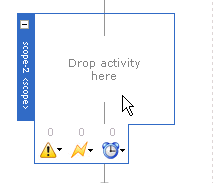
Drag activities from the BPEL Palette to build the function within the scope.
You can also drag the activities composing a function from your existing flow in the Process Map and drop them into the scope.
|
See Also: The following documentation for examples of creating scope activities in JDeveloper BPEL Designer: |
A BPEL application can generate and receive fault messages. The throw activity has three elements: its name, the name of the faultName, and the faultVariable. If you add a throw activity to your BPEL process, it automatically includes a copy rule that copies the fault name and type into the output payload. The fault thrown by a throw activity is internal to BPEL. You cannot use a throw activity on an asynchronous process to communicate with a client. Here is a code sample of a throw activity, which includes the fault elements, name, and partner link of the service to which the BPEL process sends the fault, and the copy rule that packages the message:
<throw name="delay" faultName="fault-1" faultVariable="fVar"/> <invoke name="invokeStockQuoteService" partnerLink="StockQuoteService"/> <assign> <copy> <from variable="response" part="result" query="/result"/> <to variable="output" part="payload" query="/tns:result"/> </copy> </assign>
|
See Also: The following documentation for examples of creating throw activities:
|
A BPEL process can send a fault to another application to indicate a problem, as opposed to throwing an internal fault. In a synchronous operation, the reply activity can return the fault. In an asynchronous operation, the invoke activity performs this function.
The syntax of a reply activity that returns a fault in a synchronous interaction is as follows:
<reply partnerlinke="partner-link-name" portType="port-type-name" operation="operation-name" variable="variable-name" (optional) faultName="fault-name"> </reply>
Always returning a fault in response to a synchronous request is not very useful. It is better to make the activity part of a conditional branch, where the first branch is executed if the data requested is available. If the requested data is not available, then the BPEL process returns a fault with this information.
|
See Also:
|
In an asynchronous interaction, the client does not wait for a reply. The reply activity is not used to return a fault. Instead, the BPEL process returns a fault using a callback operation on the same port type that normally receives the requested information, with an invoke activity.
|
See Also:
|
If a fault is not handled, it creates a faulted state that migrates up through the application and can throw the entire process into a faulted state. To prevent this, contain the parts of the process that have the potential to receive faults within a scope. As described earlier, the scope activity includes fault handling capabilities. The catch activity works within a scope to catch faults and exceptions before they can throw the entire process into a faulted state.
You can use specific fault names in the catch activity to respond in a specific way to an individual fault. To catch any faults that are not already handled by name-specific catch activities, use the catchAll activity.
|
See Also: The following documentation for examples of creating fault handling:
|
There is often a need to use an activity that does nothing. An example is when a fault must be caught and suppressed. In this case, you can use the empty activity to insert a no-op instruction into a business process. The syntax to use an empty activity is as follows:
<empty standard-attributes>
standard-elements
</empty>
If no catch or catchAll is selected, the fault is not caught by the current scope and is rethrown to the immediately enclosing scope. If the fault occurs in (or is rethrown to) the global process scope, and there is no matching fault handler for the fault at the global level, the process terminates abnormally. This is as though a terminate activity (described in "Using the Terminate Activity to Stop a Business Process Instance") had been performed.
Consider the following example:
<faulthandlers>
<catch faultName="x:foo">
<empty/>
</catch>
<catch faultVariable="bar">
<empty/>
</catch>
<catch faultName="x:foo" faultVariable="bar">
<empty/>
</catch>
<catchAll>
<empty/>
</catchAll>
</faulthandlers>
Assume that a fault named x:foo is thrown. The first catch is selected if the fault carries no fault data. If there is fault data associated with the fault, the third catch is selected if the type of the fault's data matches the type of variable bar. Otherwise, the default catchAll handler is selected. Finally, a fault with a fault variable whose type matches the type of bar and whose name is not x:foo is processed by the second catch. All other faults are processed by the default catchAll handler.
Compensation occurs when the BPEL process cannot complete a series of operations after some of them have already completed, and the BPEL process must backtrack and undo the previously completed transactions. For example, if a BPEL process is designed to book a rental car, a hotel, and a flight, it may book the car and the hotel and then be unable to book a flight for the right day. In this case, the BPEL flow performs compensation by going back and unbooking the car and the hotel.
You can invoke a compensation handler by using the compensate activity, which names the scope for which the compensation is to be performed (that is, the scope whose compensation handler is to be invoked). A compensation handler for a scope is available for invocation only when the scope completes normally. Invoking a compensation handler that has not been installed is equivalent to using the empty activity (it is a no-op). This ensures that fault handlers do not have to rely on state to determine which nested scopes have completed successfully. The semantics of a process in which an installed compensation handler is invoked more than once are undefined.If an invoke activity has a compensation handler defined inline, then the name of the activity is the name of the scope to be used in the compensate activity. The syntax is as follows:
<compensate scope="ncname"? standard-attributes>
standard-elements
</compensate>
The ability to explicitly invoke the compensate activity is the underpinning of the application-controlled error-handling framework of Business Process Execution Language for Web Services Specification. You can use this activity only in the following parts of a business process:
In a fault handler of the scope that immediately encloses the scope for which compensation is to be performed.
In the compensation handler of the scope that immediately encloses the scope for which compensation is to be performed.
For example:
<compensate scope="RecordPayment"/>
If a scope being compensated by name was nested in a loop, the BPEL process invokes the instances of the compensation handlers in the successive iterations in reverse order.
If the compensation handler for a scope is absent, the default compensation handler invokes the compensation handlers for the immediately enclosed scopes in the reverse order of the completion of those scopes.
The compensate form, in which the scope name is omitted in a compensate activity, explicitly invokes this default behavior. This is useful when an enclosing fault or compensation handler must perform additional work, such as updating variables or sending external notifications, in addition to performing default compensation for inner scopes. The compensate activity in a fault or compensation handler attached to the outer scope invokes the default order of compensation handlers for completed scopes directly nested within the outer scope. You can mix this activity with any other user-specified behavior except for the explicit invocation of the nested scope within the outer scope. Explicitly invoking a compensation for such a scope nested within the outer scope disables the availability of default-order compensation.
The terminate activity immediately terminates the behavior of a business process instance within which the terminate activity is performed. All currently running activities must be terminated as soon as possible without any fault handling or compensation behavior. The terminate activity does not send any notifications of the status of a BPEL process. If you are going to use the terminate activity, first program notifications to the interested parties.
The syntax for the terminate activity is as follows:
<terminate standard-attributes>
standard-elements
</terminate>
|
See Also: The following documentation for examples of creating terminate activities:
|
The following procedure shows how to use the provided examples to generate a fault and define a fault handler to catch it. In this case, you modify a WSDL file to generate a fault, and create a catch attribute to catch it.
Import RuntimeFault.wsdl into your process WSDL (located under the Oracle_Home\integration\orabpel\system\xmllib directory).
Declare a variable with messageType bpelx:RuntimeFaultMessage.
Catch it using <catch faultName="bpelx:remoteFault" | "bpelx:bindingFault" faultName="varName">.
To define a fault handler in Eclipse BPEL Designer, follow these steps:
Drag a scope activity from the BPEL Palette and place it just above the credit rating invoke activity.
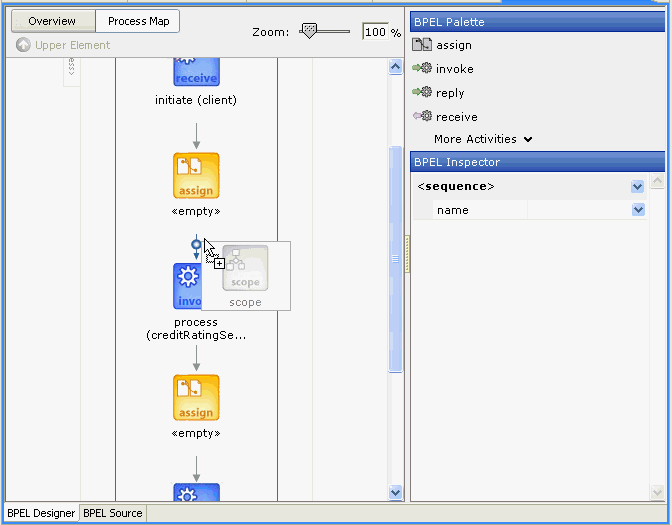
Expand the scope activity by clicking its Expand button and drag the invoke credit rating activity into the scope activity.
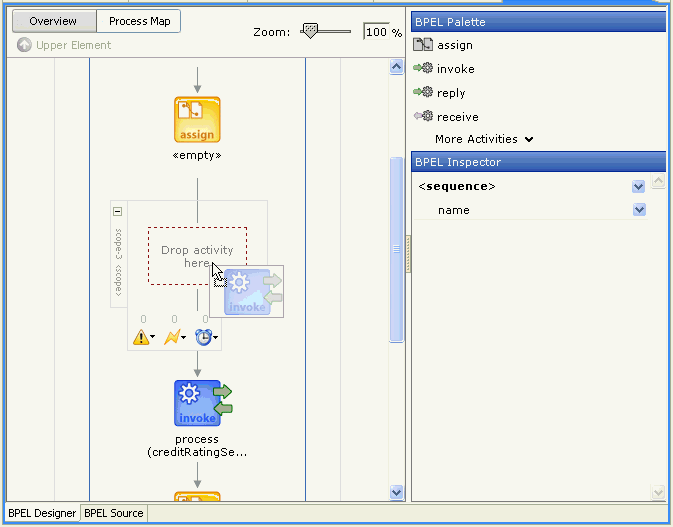
At the bottom of the scope area, there are three icons: a caution sign, a lightning bolt, and a clock. The caution sign represents a fault handler.
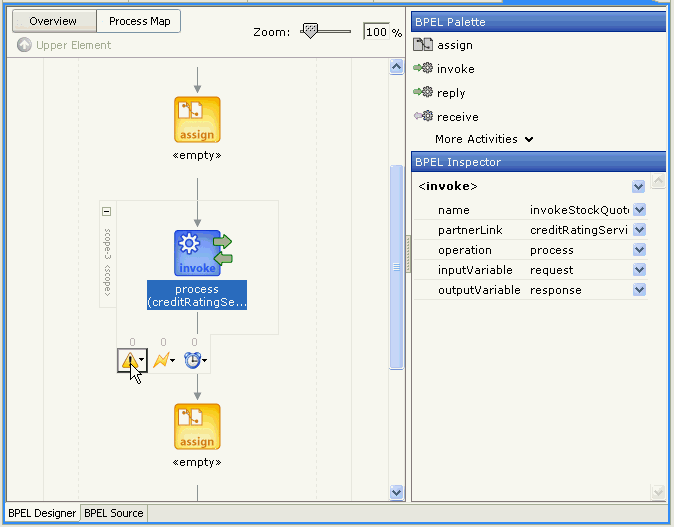
Click the caution sign, and select Add catch from the menu.
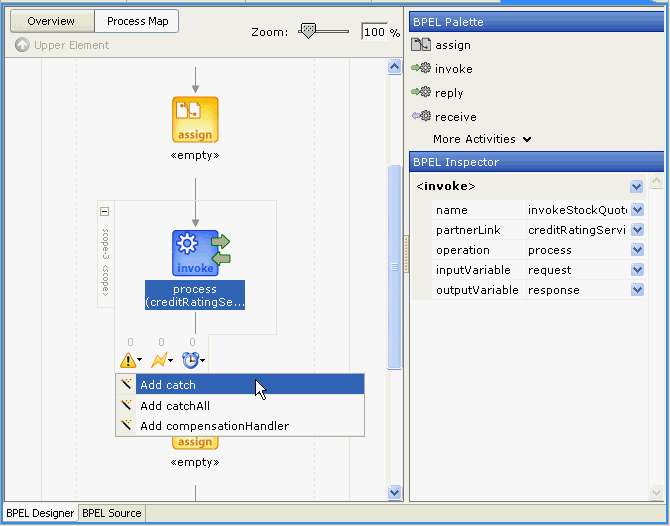
The New Catch Wizard window appears:
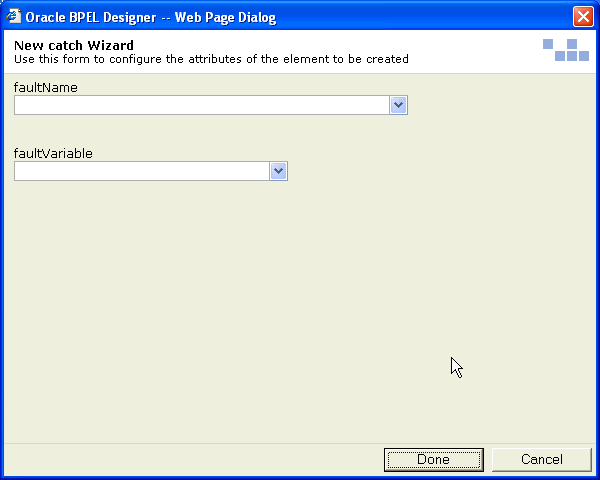
Select the fault name and the fault variable from the lists provided.
This defines where the fault comes from and which fault activates the fault handler.
Drag an assign activity into the BPEL process below the catch activity.
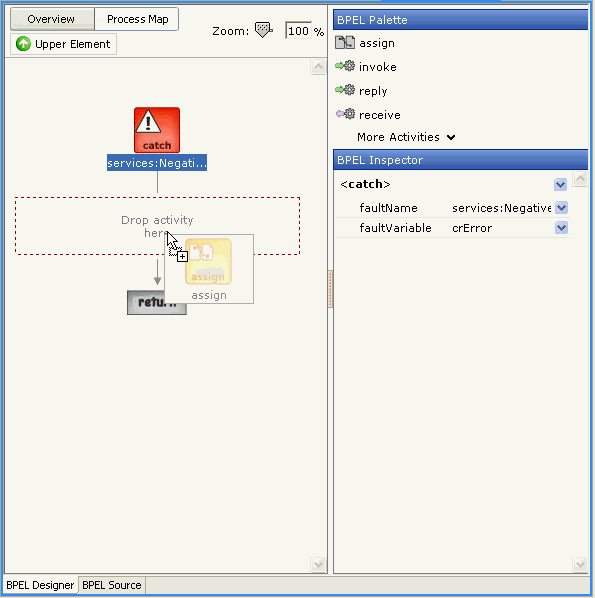
Add copy rules to the assign activity. In the BPEL Inspector, select Add Copy Rule from the menu.
This defines what the BPEL flow does when it receives the defined fault.
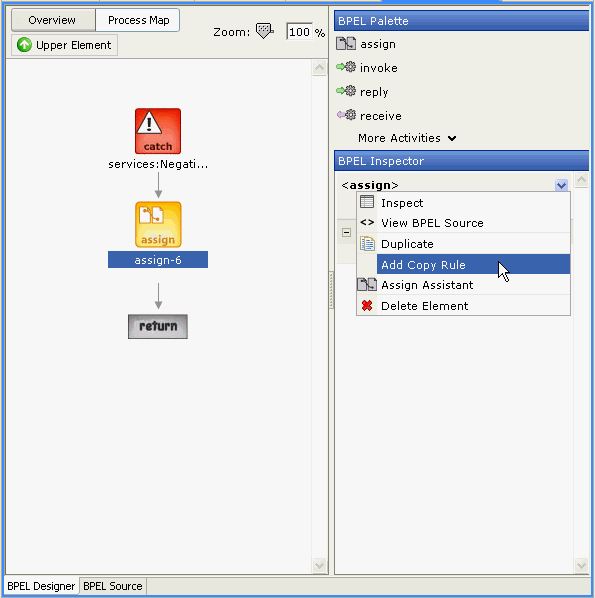
Click the Upper Element button to return to the Process Map view.
|
See Also: The following documentation for examples of defining fault handling:
|